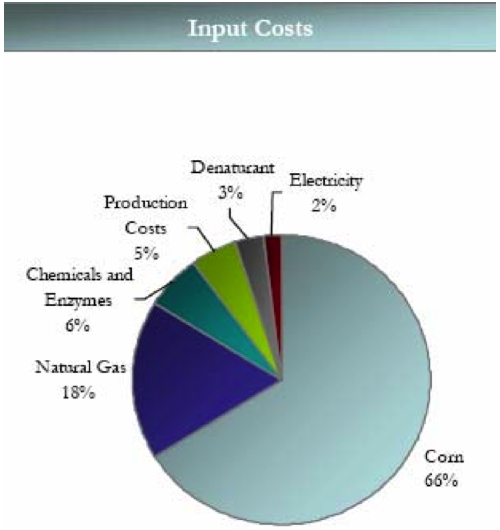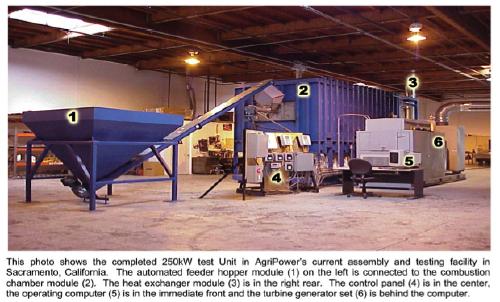Archive for the 'Biomass' Category
What are the costs to produce ethanol?

Another interesting tidbit picked up at REFF was what the requisite input costs are in the production of ethanol in the US. The pie chart above shows that the largest cost of input by far is the feedstock, corn at 66%. The cellulosic approach definitely makes sense as it attacks this major cost of production – one has to wonder if nations like Brazil, where 40% of their transport fuels are ethanol, experience a similar input cost percentage using sugar cane as the feedstock?
The next large cost is natural gas used in the distilling process. The natural gas and feedstock costs account for 84% of the production cost for ethanol! Unbelievable. Changing the equation of production costs will definitely have an impact on the future of the fuel. Corn prices have doubled as the demand for ethanol has increased. Natural gas prices have doubled in the past 6 years. Unless these trends moderate or the production methodology changes to break from the dependance on natural gas and corn, ethanol will become ever more expensive to produce. Comments are off for this post
Biomass to go

AgriPower, a biomass equipment provider, has created and tested a new transportable biomass power unit that outputs net 225kw. This is an interesting technology as it can be taken to where the fuel is located for distributed generation rather than causing the fuel to be transported to a large, central generation site. Comments are off for this post
The View from REFF
Today we’re attending the Renewable Energy Financing Forum sponsored by ACORE in NY. Thus far, there have been two very interesting sessions on Biomass/biofuels and Solar (PV). The panels have been informative, a mix of executives from established companies in the segments and investors (mostly public market.)
In his opening remarks this morning, Michael Eckhart, the President of ACORE, walked through the various renewable resources and he singled out geothermal as being the ONLY renewable capable of displacing coal baseload generation. Curiously, there is not a geothermal session in this conference and we here from the Geothermal Energy Association, Geothermal Resources Council, or even a single geothermal industry attendee from the Geothermal Financing Workshops over the past year. This is a missed opportunity.
A few key points from this morning’s session were:
- 10% of venture capital investments in 2006 were in renewable energy
- 1.6B people do not have access to electricity (perhaps we ought to solve the power divide too…)
- 20% of US corn output is used to make ethanol, that is predicted to rise to 30% by 2010
- 2/3 of the cost of ethanol in the US is due to fuel stock (corn) prices
- Aggregate market capitalization for US solar companies has increased from $1B in 2004 to $67.3B now
- It takes between 2-4 years of electricity production of a solar cell to offset it’s electrical and environmental impact of manufacture
- Refined silicon costs on the spot market have increased from $50/kg two years ago to over $250/kg now. Long term contracts can be had for $70/kg. The cost of Si is forecast to decrease to $40/kg over the next 2 years.
Those are facts we found interesting, we’ll share more on the afternoon’s sessions in future entries.
Comments are off for this post
90.5 million acres of corn planted
This constitutes a 15% increase from 2006 and the largest corn planting in over 60 years. The demand for corn is being driven largely by the use of corn to produce ethanol (though other types of plants have greater ethanol yields in other places, like sugar cane in Brazil.)
Since farming is something of a zero sum game, other species of crops will decrease as a natural consequence of the bull run on corn, notably soy beans which have decreased to 67.1M acres in 2007. The US Department of Agriculture released a report this morning detailing these shifts and more.
Enel acquires AMP Resources
Fifteen months after agreeing to be acquired by Raser Technologies, and six months after backing out of that deal, AMP Resources has agreed to be acquired by Italian power company Enel. The jewel in Enel’s portfolio is the Larderello geothermal plant which has been in operation since 1906.
The headline on this deal is “Enel buys into US Market with 150MW acquisition of AMP Resources” but this is misleading as headlines can often be. That’s not to say that AMP’s assets are without value, it’s simply overstating what AMP has to justify a wild premium paid for those assets. AMP, according to its website, has the following assets:
- 21MW nameplate Stillwater, Nevada geothermal plant and a second undeveloped anomaly on the lease
- 12MW Cove Fort, Utah lease on 4,000 acres (the plant was closed for upgrade)
- Salt Wells, Nevada lease of 3,000 acres (no plant)
- Surprise Valley, California lease of 5,000 acres (no plant)
- Undisclosed intellectual property related to Kalina cycle binary heat systems
Obviously, there may be other assets AMP has that are not enumerated on their web site, but that is what’s visible. The only functional and productive plant in the portfolio is Stillwater with a nameplate output of 21MW. However, our research indicates the average net output from the plant is on the order of 10MW at any given time due to high parasitic load consisting of cooling and pumping both geothermal resource and working fluid around the plant. A generous valuation for this asset is $30M.
The “brownfield site” of Cove Fort, Utah has much less risk than other undeveloped properties and as such should be assigned more value. It was producing gross 12MW before it was shut down for upgrade. It’s unclear where that project is at present, but until the upgrade is complete, it’s difficult to assign more value than when the plant was operational, call a generous valuation $20M.
That leaves the undeveloped properties including the area in the Stillwater lease that is still untapped. According to a PIER report for the San Francisco Public Utilities Commission from 2004, the Stillwater site has a most likely rating of 32MW gross and if we use the existing plant as the benchmark, we would expect no more than 15MW net to be harvested. This is undeveloped but known resource, a generous valuation is $1.5M.
The other two properties at Salt Wells and Surprise Valley are early development stages, but have their charms like location close to transmission lines and some early exploration and sizing work complete. However, at this stage, generous valuation of these properties taken together is no more than $2M.
Finally, there is the IP and associated products. With the entry of companies like UTC into the binary harvest market, these assets are far less valuable than a few years ago. Between Ormat and UTC, it’s hard to see AMP and now Enel competing effectively in the binary system space. I don’t know how to value this asset, but the total is likely much less than the differential between the purchase price and the sum of the tangible assets enumerated above.
My conclusion is that with a $90M acquisition price tag, Enel has paid a $36.5M, or 40% premium over the intrinsic value of the corporation and assets. Admittedly, that values the IP at $0, but the tangible assets are all priced above at the high end of the pricing spectrum which means that the IP is likely priced appropriately relative to the actual value of the tangible assets. We’ll see if this deal ultimately goes through, after the prior deal fell apart with Raser, there is a precedent and some reason for skepticism.
Disclosure statement: The principals of Montara Energy Ventures hold no shares in and have no other financial relationship with Raser Technologies, AMP Resources, or Enel.








